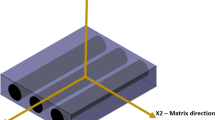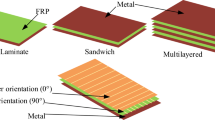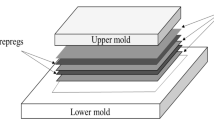Abstract
This paper presents an experimental and numerical investigation into the effect of pre-heat temperature on stretch forming of a fibre metal laminate (FML) comprised of alternating layers of steel and woven (0/90) glass-fibre polypropylene in a 2:1 configuration. Hourglass sample geometries were formed in an open die and real-time photogrammetry was used to measure the evolution of strain fields over the lower surface of each sample. The sample pre-heat temperatures were 140 °C (above the crystallization temperature) and 170 °C (melt temperature of polypropylene). For each temperature, a forming limit curve (FLC) was determined based on ISO 12004-2:2008 and compared to the FLC of the steel skin. The experimental results demonstrate that pre-heat temperature of 140 °C enables sufficient matrix flow such that the formability of the FML is comparable to the formability of the steel sheet. Furthermore, the FML stretch-forming process was simulated using commercial finite element software, LSDYNA, with an explicit solver. The glass-fibre polypropylene material behaviour was simulated with a curve fitting technique of material characterization test results. A user-defined subroutine (UMAT) was developed for the composite material modelling through all process temperatures. The simulation, justified with experiments, provided a numerical model of the hybrid material to utilise for forming complex shapes.















Similar content being viewed by others
References
Reyes G, Cantwell WJ (2000) The mechanical properties of fiber-metal laminates based on a glass fibre reinforced polypropylene. Composites science and technology 9(7):211–216. https://doi.org/10.1016/S0266-3538(00)00002-6
Reyes G, Kang H (2007) Mechanical behavior of lightweight thermoplastic fiber-metal laminates. J Mater Process Technol 186(1-3):284–290. https://doi.org/10.1016/j.jmatprotec.2006.12.050
Vogelesang LB, Vlot A (2000) Development of fibre metal laminates for advanced aerospace structures. J Mater Process Technol 103(1). https://doi.org/10.1016/S0924-0136(00)00411-8
Compston P, Cantwell WJ, Jones C, Jones N (2001) Impact perforation resistance and fracture mechanisms of a thermoplastic based fiber-metal laminate. J Mater Sci Lett 20(7). https://doi.org/10.1023/A:1010904930497
Botelho EC, Silva RA, Pardini LC, Rezende MC (2006) A review on the development and properties of continuous Fiber / epoxy / aluminum hybrid composites for aircraft structures. Mater Res 9(3). https://doi.org/10.1590/S1516-14392006000300002
Keeler S, Backhofen W (1964) Plastic instability and fracture in sheet stretched over rigid punches. ASM Transactions Quarterly 56:25–48
Nakazima, K., Kikuma, T., Hasuka K (1968) Study on the formability of steel sheets. Technical Report Yawata Technical Report
Marciniak Z, Kuczyński K (1967) Limit strains in the processes of stretch-forming sheet metal. Int J Mech Sci 9(9):609–620. https://doi.org/10.1016/0020-7403(67)90066-5
ISO/DIS 12004–2 (2008) Metallic Materials - Sheet and Strip - Determination of Forming Limit Curves - Part 2: Determination of Forming Limit Curves in the Laboratory. International Organization for Standardization 20087. 2:12004
Sokolova O, Carradó A, Palkowski H (2010) Production of customized high-strength hybrid Sandwich structures. Adv Mater Res 137:81–128. https://doi.org/10.4028/www.scientific.net/AMR.137.81
Mosse L, Compston P, Cantwell WJ, Cardew-Hall M, Kalyanasundaram S (2006) Stamp forming of polypropylene based fibre-metal laminates: the effect of process variables on formability. J Mater Process Technol 172(2):163–168. https://doi.org/10.1016/j.jmatprotec.2005.09.002
Mosse L, Compston P, Cantwell WJ, Cardew-Hall M, Kalyanasundaram S (2006) The development of a finite element model for simulating the stamp forming of fibre-metal laminates. Compos Struct 75(1-4):298–304. https://doi.org/10.1016/j.compstruct.2006.04.009
Gresham J, Cantwell W, Cardew-Hall MJ, Compston P, Kalyanasundaram S (2006) Drawing behaviour of metal-composite sandwich structures. Compos Struct 75(1-4):305–312. https://doi.org/10.1016/j.compstruct.2006.04.010
Mosse L, Compston P, Cantwell WJ et al (2005) The effect of process temperature on the formability of polypropylene based fibre-metal laminates. In: composites part a: applied science and manufacturing, pp 1158–1166
Compston P, Cantwell WJ, Cardew-Hall MJ, Kalyanasundaram S, Mosse L (2004) Comparison of surface strain for stamp formed aluminum and an aluminum-polypropylene laminate. J Mater Sci 39(19):6087–6088. https://doi.org/10.1023/B:JMSC.0000041707.68685.72
Sexton A, Cantwell W, Kalyanasundaram S (2012) Stretch forming studies on a fibre metal laminate based on a self-reinforcing polypropylene composite. Compos Struct 94(2):431–437. https://doi.org/10.1016/j.compstruct.2011.08.004
Rajabi A, Kadkhodayan M, Manoochehri M, Farjadfar R (2015) Deep-drawing of thermoplastic metal-composite structures: experimental investigations, statistical analyses and finite element modeling. J Mater Process Technol 215. https://doi.org/10.1016/j.jmatprotec.2014.08.012
Wollmann T, Hahn M, Wiedemann S, Zeiser A, Jaschinski J, Modler N, Ben Khalifa N, Meißen F, Paul C (2018) Thermoplastic fibre metal laminates: stiffness properties and forming behaviour by means of deep drawing. Archives of Civil and Mechanical Engineering 18(2). https://doi.org/10.1016/j.acme.2017.09.001
Jalali Aghchai A, Khatami S (2018) Experimental and numerical formability investigation of FML sheets with glass fiber reinforced core. Int J Adv Manuf Technol 96:9–12. https://doi.org/10.1007/s00170-018-1836-x
Zhu B, Yu TX, Tao XM (2009) Large shear deformation of E-glass/ polypropylene woven fabric composites at elevated temperatures. J Reinf Plast Compos 28(21):2615–2630. https://doi.org/10.1177/0731684408093095
Hou M, Friedrich K (1994) 3-D stamp forming of thermoplastic matrix composites. Appl Compos Mater 1(2):135–153. https://doi.org/10.1007/BF00567575
MacHado M, Murenu L, Fischlschweiger M, Major Z (2016) Analysis of the thermomechanical shear behaviour of woven-reinforced thermoplastic-matrix composites during forming. Compos A: Appl Sci Manuf 86:39–48. https://doi.org/10.1016/j.compositesa.2016.03.032
Tepex® Dynalite (2014) Material Data Sheet. http://bond-laminates.com/uploads/tx_lxsmatrix/ 600:7072
ARAMIS (2009) ARAMIS user manual
Marciniak Z, Duncan J, Hu SJ (2002) Mechanics of sheet metal forming
D 3518 (2007) Standard test method for in-plane shear response of polymer matrix composite materials by tensile test of a +−45 ° laminate. Annual Book of ASTM Standards https://doi.org/10.1520/D3518
Bogetti TA, Hoppel CPR, Harik VM et al (2004) Predicting the nonlinear response and progressive failure of composite laminates. Failure Criteria in Fibre-Reinforced-Polymer Composites 64:402–428. https://doi.org/10.1016/B978-008044475-8/50017-2
Wang W, Lowe A, Kalyanasundaram S (2016) Investigating the forming limits of a flax fibre-reinforced polypropylene composite in different water treatment conditions. International journal of advanced manufacturing technology 1–11
Wang W, Lowe A, Davey S, Akhavan Zanjani N, Kalyanasundaram S (2015) Establishing a new forming limit curve for a flax fibre reinforced polypropylene composite through stretch forming experiments. Compos A: Appl Sci Manuf 77:114–123. https://doi.org/10.1016/j.compositesa.2015.06.021
Ls-dyna, software LS, Orporation TEC (2017) Theory Manual 01/26/18
Acknowledgements
This research is supported by an Australian Government Research Training Program (RTP) Scholarship.
Author information
Authors and Affiliations
Corresponding author
Ethics declarations
Conflict of interest
The authors declare that they have no conflict of interest.
Additional information
Publisher’s note
Springer Nature remains neutral with regard to jurisdictional claims in published maps and institutional affiliations.
Rights and permissions
About this article
Cite this article
Rahiminejad, D., Compston, P. The effect of pre-heat temperature on the formability of a glass-fibre/polypropylene and steel-based fibre–metal laminate. Int J Mater Form 14, 715–727 (2021). https://doi.org/10.1007/s12289-020-01566-9
Received:
Accepted:
Published:
Issue Date:
DOI: https://doi.org/10.1007/s12289-020-01566-9




